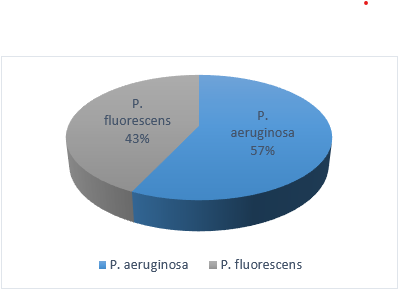Inhibition of Catheter Biofilm-Acquired Urinary Tract Infections by Purified Pyoverdine from Pseudomonas aeruginosa Isolated from Agricultural Soils
Abstract
One of the most prevalent healthcare-acquired diseases is catheter-acquired urinary tract infection because of use of catheters can result in the introduction of bacteria into the bladder. Pyoverdine production was assessed qualitatively and quantitatively in all Pseudomonas spp. isolates and in comparison to P. fluorescens, P. aeruginosa isolates produced the most pyoverdine, ranging from 1.45 to 2.23 %. Pyoverdine was purified on a Sephadex G-150 column and produced three peaks with pyoverdine levels of 2.13 to 4.54|%. The purified pyoverdine led to inhibition of biofilm formation with 62-85 % after 24 hours and increased to 69-89 % after 48 hours. The highest percentage of inhibition was found in Escherichia coli isolates, followed by 77 % in Enterococcus faecalis, while lesser inhibition was found in Proteus mirabilis at 62 %
References
Laxmi, B.M. and Bhat,S.G. (2016).Cterization of pyocyanin with radical scavenging and antibiofilm properties isolated from Pseudomonas aeruginosa strain. J. Biotech.,6: 27-32.
Xiao, G.R. Kisaalita, W.S. (2012). Purification of Pyoverdines of Pseudomonas fluorescens 2-79 by Copper-Chelate Chromatography. Applied and Environmental Microbiology., 61(11):33-38.
Lindsay, E. and Nicolle, L. E.(2014). Catheter associated urinary tract infections. Nature Immunology, 3(23):2-8.
Meyer, J.M. (2000) Pyoverdines: pigments, siderophores and potential taxonomic markers of fluorescent Pseudomonas species. Arch Microbiol 174:135–142.
Kerr, J.R.; Taylor, G.W.; Rutman, A.; Hoiby, N.; Cole, P.J. and Wilson, R. (1999). Pseudomonas aeruginosa Pyocyanin and 1-hydroxyphenazine inhibit fungal growth. Clin Pathol.; 2:385–387.
Nicolle, L.E.(2001). The chronic indwelling catheter and urinary infection in long term care facility residents. Infect Control Hosp Epidemiol., 22:316–321.
Warren, J.W.(1991). The catheter and urinary tract infection. Med Clin North Am., 75:481–493.
Ouno, G.A.; Korir, S.C.; Cheruiyot, J.C. Ratemo, O.D.; Mabeya, B.M.; Mauti, G.O.; Mauti, E.M. and Kiprono, S.J. (2013). Isolation, Identification and Characterization of Urinary Tract Infectious Bacteria and the Effect of Different Antibiotics. J. Natural Sciences Research, 3(6): 150-156.
Ouno, G.A.; Korir, S.C.; Cheruiyot, J.C. Ratemo, O.D.; Mabeya, B.M.; Mauti, G.O.; Mauti, E.M. and Kiprono, S.J. (2013). Isolation, Identification and Characterization of Urinary Tract Infectious Bacteria and the Effect of Different Antibiotics. J. Natural Sciences Research, 3(6): 150-156.
Schywn, B.; Neilands, J.B. (2009).Universal chemical assay for the detection and determination of siderophores. Anal. Biochem., 160, 47–56.
Xao R. and Kisaalita, W.S.(2004).Purification of Pyoverdines of Pseudomonas fluorescens 2-79 by Copper-Chelate Chromatography Applied And Environmental Microbiology, 61(11):3769–3774.
Meyer, J.M. and Abdallah, M.A.(2007). The fluorescent pigment of Pseudomonas fluorescens: Biosynthesis, purification and physicochemical properties. J. Gen. Microbiol., 107, 319–32
Marak, M.B. and Dhanashree, B.(2018). Antifungal Susceptibility and Biofilm Production of Candida spp. Isolated from Clinical Samples. International Journal of Microbiology, 5 pages
Ryan, K.J. and Ray, C.G.(2004). Medical microbiology. McGraw Hill, 4: 370.
Deziel, E.; Paquette, G.; Villemur, R.; Lepine, F. and Bisaillon, J.(1996). Biosurfactant Production by a Soil Pseudomonas Strain Growing on Polycyclic Aromatic Hydrocarbons. Appli. Environ. Microbiol. 62(6):1908–1912.
Höfte, M. and deVos, P.(2006). Plant pathogenic Pseudomonas species. In: Gnanamanickam SS, editor. Plant-Associated Bacteria. Springer. Liao CS, Chen LC, Chen B.
Lin, S.H. (2010). Bioremediation of endocrine disruptor di-n-butyl phthalate ester by Deinococcus radiodurans and Pseudomonas stutzeri. Chemosphere.;78(3):342–346.
Santoyo, G.; Orozco-Mosqueda, M.D. and Govindappa, M.(2012). Mechanisms of biocontrol and plant growth-promoting activity in soil bacterial species of Bacillus and Pseudomonas: a review. Biocontrol Sci. Technol.;22(8):855–872.
Sharma, S. and Pathak, J. (2014). Pseudomonas in biodegradation. Int. J. Pure Appl. Biosci.; 2(2):213–222.
Agarwal,D.; Rokkala,D.; TawdeS.; Bhatia,P.; Ratho,S.(2021). Isolation of Pseudomonas species from soil sample forproduction of Pyoverdine and evaluation of its potential as anantimicrobial agent. Int J Sci Res Sci & Technol., 8 (5) : 355-361.
Dedeić-Ljubović*, A. and Hukić, M.(2009).Catheter-related urinary tract infection in patients suffering from spinal cord injuries. Bosn J Basic Med Sci.; 9(1): 2–9.
Stevens, D.A. (2017). Studies of Pseudomonas aeruginosa Mutants Indicate Pyoverdine as the Central Factor in Inhibition of Aspergillus fumigatus Biofilm. J. Bacteriol.,200 (1):212-218.
Raoof, W.M. and Latif, A.A.R. (2010) In vitro study of the swarming phenomena and antimicrobial activity of pyocyanin produced by Pseudomonas aeruginosa isolated from different human infections. Eur J Sci Res., 47:405–4.







